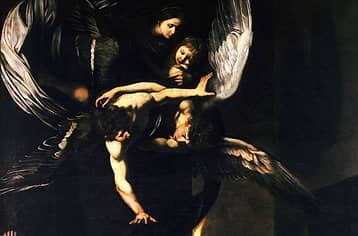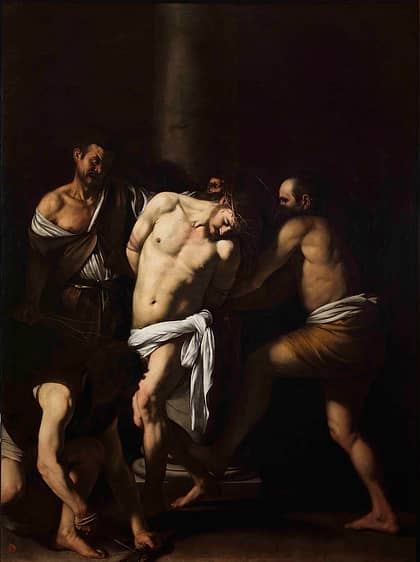- Home
- Experiences
- Caravaggio and the Neapolitan Baroque
Caravaggio and the Neapolitan Baroque


Guided tour "Caravaggio a Napoli"
Michelangelo Merisi da Caravaggio, better known as Caravaggio, spent some of the final years of his life and career in Naples, leaving valuable masterpieces in the city and deeply influencing the Neapolitan art movement of the 17th century.
Caravaggio's Flight from Rome and Arrival in Naples
Caravaggio's Flight from Rome and Arrival in Naples
At the height of his career in Rome, Caravaggio was involved in a violent quarrel that broke out in the middle of a sporting match which resulted in the death of Ranuccio Tomassoni, a bookie and ruffian - but also the son of a high Papal official - well known in Rome in the early 1600s.
Caravaggio, who had altercations with the victim in the past, was charged with murder and sentenced to death by beheading for this crime. The sentence could be carried out on the spot by anyone who came across the fugitive painter, so he decided to escape Naples. He first arrived in September of 1606 and then returned a second time in 1609 after a stay in Sicily and on the island of Malta.
Caravaggio in Naples
Caravaggio in Naples
Caravaggio found protection from the Carafa family as well as a fertile market for his work in Naples’ Quartieri Spagnoli. He received important commissions and wide appreciation for his work, changed the city's artistic movement forever, and created numerous important masterpieces during his few years in the city. Only three works by Caravaggio have remained in Naples: "The Flagellation of Christ", "The Seven Works of Mercy", and "The Martyrdom of St. Ursula". His paintings during the Neapolitan period are intense, dramatic, and characterized by a strong contrast between light and shadow (known as the “chiaroscuro” technique), dark backgrounds, and colorful characters inspired by Neapolitan street life.
The Flagellation of Christ
The Flagellation of Christ

The Flagellation of Christ is a large oil painting completed by Caravaggio between 1607 and 1608 and displayed in the National Museum of Capodimonte in Naples. It was commissioned by Tommaso de Franchis for the family chapel in the Church of San Domenico Maggiore; the artist produced a fairly traditional composition to satisfy the client, depicting the figure of Christ tied to a column and with head bent under the crown of thorns.
As in many of Caravaggio's works, light plays an important role this large Neapolitan canvas. The martyred body of Christ is illuminated in the center of the composition to highlight it against the dark background and his tormentors almost hidden in shadow. The overall scene is dramatic and charged with emotion, in perfect Caravaggesque style.
The artist had many second thoughts regarding the composition on the lower section of the canvas, marked by a series of changes and reworkings that may have been carried out to satisfy the client.
"The Flagellation of Christ" is displayed in the Capodimonte Museum in the Capodimonte Palace located on a hilltop above Naples.
Visiting Information:
Opening hours: Daily except Wednesday from 8:30 AM to 7:30 PM. Closed on January 1st and December 25th.
Tickets: €12; €2 for visitors between 18 and 25; free for visitors under 18.
Getting there: bus 168 and 178 (Porta Piccola stop); bus C63 (Porta Grande stop); bus 604 (Viale Colli Aminei stop); or the Capodimonte shuttle from Piazza Trieste and Trento.
The Seven Works of Mercy
The Seven Works of Mercy

Another work completed during the artist’s first Neapolitan period was commissioned by the Congregation of the Pio Monte della Misericordia, which included Luigi Carafa-Colonna (a member of the Carafa family that protected the painter in Naples after his escape from Rome).
The altarpiece painting portrays The Seven Works of Mercy (also known as "The Seven Acts of Mercy") and is housed in the Church of Pio Monte della Misericordia in Naples. Like in other works by Caravaggio, the characters seem to emerge from the darkness and infuse the scene with striking naturalism and intensity in the dramatic composition.
Visiting Information
Opening hours: Monday to Saturday from 10:00 AM to 6:00 PM and Sunday from 9:30 AM to 2:30 PM.
Tickets: €8; €6 for visitors under 25. 3D viewer and AR experience: €10 supplement.
Getting there: Dante stop on Metro Line 1 or Cavour stop on Metro Line 2.
The Return to Naples and the Martyrdom of St. Ursula
The Return to Naples and the Martyrdom of St. Ursula

The last known work of Caravaggio, "The Martyrdom of Saint Ursula" was quickly in 1610 just weeks before the artist departed for Porto Ercole seeking the Pope’s pardon but instead met his untimely end. Today it is displayed in the Gallerie d’Italia located inside the baroque Palazzo Zevallos Stigliano on Via Toledo in the historic center.
For years, "The Martyrdom of Saint Ursula" had been attributed to painter Mattia Preti, but the discovery of a letter from 1610 proved its commission by the banker Genoese Marcantonio Doria to Caravaggio.
Visiting Information
Opening hours: Tuesday to Friday from 10:00 AM to 7:00 PM; Saturday and Sunday from 10:00 AM to 8:00 PM; closed on Mondays.
Tickets: €7; €4 for visitors over 65; free for visitors under 18. Free for everyone every first Sunday of the month.
There are numerous Caravaggio paintings dating from the artist’s time in Naples now housed in some of the most important art galleries in Italy and across the globe, including "Salome with the Head of John the Baptist", the "Crucifixion of Saint Andrew", and a famous "Madonna del Rosario" in Vienna’s Kunsthistorisches Museum.
You can also see works by Caravaggio from other periods of his career in the Metropolitan Museum of Art in New York City, the National Gallery in London, Rome’s Borghese Gallery, and the Uffizi Gallery in Florence.
Caravaggio and the Neapolitan Baroque
Caravaggio and the Neapolitan Baroque
The presence of Caravaggio in Naples had a strong influence on the city’s artistic movement, as witnessed by the evolution of a local baroque school inspired by the artist and reflected in the works of Battistello Caracciolo, Massimo Stanzione, Jusepe de Ribera, Bernardo Cavallino, Artemisia Gentileschi, and Mattia Preti, as well as the famous painter Luca Giordano.
Many of the museums and baroque churches of the historic center of Naples are home to paintings and other works of art from this period. The most important examples of the Neapolitan Baroque include the Church of Gesù Nuovo in the historic center, the Charterhouse of San Martino, the Chapel of the Treasury of San Gennaro, the interiors of the Duomo, and the Sansevero Chapel, which houses the famous Veiled Christ.